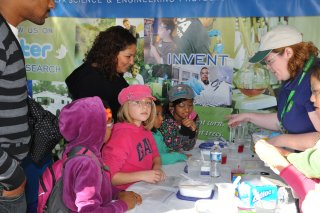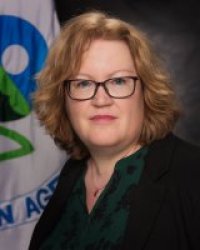Why Representation Matters for Girls and Women in STEM
When I am asked how I got started in my science career, I always come back to a 6th grade book report assignment. I chose to do a book report on Dr. Marie Curie, who won the Nobel Prize for physics in 1903. It was fascinating to read about her work and learn about what she went through to simply do her research and to find answers to questions because she thought it was important. Her impacts were extraordinary, especially in a job that women did not usually hold at that time.
As we celebrate International Day of Women and Girls in Science, I’m happy to see that things have come a long way since Marie Curie first began her research. I’m also pleased to see that women are being recognized for their contributions in the sciences. This gives more opportunities for girls to have role models who are like them.

For years I have spent time on science education outreach with a variety of audiences to encourage young students to explore careers in science. As I reflect on my own accomplishments and journey to becoming the Principal Deputy Assistant Administrator for the Environmental Protection Agency’s (EPA's) Office of Research and Development, I hope the girls and young women from these events will see my successes in this world-class scientific organization as a possible vision for their own Science, Technology, Engineering and Mathematics (STEM) journeys. It is humbling. I worked hard, but it is because of glass ceilings shattered by so many before me and through the support of allies that I am in this position. Pioneers such as Marie Curie overcame institutional and attitudinal barriers to help change perceptions, but there is still work to be done.
The Data and Insights into Barriers
According to UNESCO's Institute for Statistics, less than 30% of the world's researchers are women. From the U.S. Census Bureau, we see progress in women’s participation in the STEM fields, but not enough:
In 1970, women made up 38% of all U.S. workers and 8% of STEM workers. By 2019, the STEM proportion had increased to 27% and women made up 48% of all workers.
Read their recent article, Women are Nearly Half of U.S. Workforce but only 27% of STEM Workers
At the EPA, women have historically accounted for a larger percentage of the total population when compared to men. At the end of fiscal year 2021, EPA’s employees were 53% female and 47% male. During that same period, women comprised 45% of the agency’s STEM positions, up 5% from 2015. As of February this year, women at EPA tend to be more educated than their male counterparts but represent only 44% of staff with doctoral degrees. Across the agency, supervisory roles and senior executive positions are within decimal places of being evenly split between males and females.

Women with a disability account for slightly more than 5% of EPA’s total population and occupy 8% of STEM positions. Women of color make up 41% of all women at EPA and represent the majority of women in the Information Technology sector at 61%. Additionally, 30% of all women in science and engineering occupational categories within the agency are women of color.
We can keep exploring this topic and the data available nationally with a report by the National Science Foundation (NSF) , titled Women, Minorities, and Persons with Disabilities in Science and Engineering, which provides statistical information about the participation of these three groups in science and engineering education and employment. One of its key takeaways:
Of all S&E degrees awarded in 2018, women earned about half of bachelor’s degrees, 44.7% of master’s degrees, and 41.2% of doctorate degrees. However, the proportion of degrees awarded to women varied by field—female S&E degree holders were most prevalent in psychology, biological sciences, and agricultural sciences and the least prevalent in computer sciences and engineering.
Read the NSF Report, Women, Minorities, and Persons with Disabilities in Science and Engineering
Guiding Principles
Giving back and being of service is another guiding principle of mine, ingrained from my childhood by my kind and giving parents. With an agency mission of protecting human health and the environment, I’m able to put this principle into practice with my EPA colleagues every day. We have an amazing team of STEM professionals who collaborate with an ace team of budget, contracts, communications, IT, and facilities experts, plus others who keep our scientific enterprise running. Our service is providing the scientific basis to support the agency and decision makers in states, tribes and communities as they work toward safe places to live, learn, work, and play. What greater service could there be?
Pursuing a STEM career isn’t always easy, as there are challenges that can deter you from your pursuit, but you can make a difference as a change agent serving as a role model of exemplary science regardless of gender or identity. I have put these guiding principles to work as the deputy principal:
- strengthening the role of science and scientific integrity in our agency’s actions
- advancing administration priorities including environmental justice
- strengthening our work with our partners in environmental protection, including communities, states, and tribes
All of this and more are geared toward continuing our legacy as an international scientific leader in developing innovative solutions to complex environmental problems. That legacy requires us to tap into the expertise of ALL who wish to pursue STEM careers. To quote Marie Curie and inspire anyone considering a STEM Career:
We must believe that we are gifted for something, and that this thing, at whatever cost, must be attained.
Marie Curie
Editor's Note: Discover more work of EPA women in STEM: Read Science Matters

About the Author
Maureen Gwinn
Maureen Gwinn, Principal Deputy Assistant Administrator
Office of Research and Development
Dr. Gwinn serves as Acting Assistant Administrator and Principal Deputy Assistant Administrator for Research and Development. She also serves as EPA's Chief Scientist. During her EPA career, Dr. Gwinn has served as the National Program Director for the Sustainable and Healthy Communities Research Program, Director of the Biomolecular and Computational Toxicology Division and contributed to multiple human health hazard assessments in support of the Integrated Risk Information System Program.
Editor’s Note: The views expressed here are intended to explain EPA policy. They do not change anyone’s rights or obligations. You may share this article. However, please do not change the title or the content, or remove EPA’s identity as the author. If you do make substantive changes, please do not attribute the edited title or content to EPA or the author.
EPA’s official web site is www.epa.gov. Some links on this page may redirect users from the EPA website to specific content on a non-EPA, third-party site. In doing so, EPA is directing you only to the specific content referenced at the time of publication, not to any other content that may appear on the same webpage or elsewhere on the third-party site, or be added at a later date.
EPA is providing this link for informational purposes only. EPA cannot attest to the accuracy of non-EPA information provided by any third-party sites or any other linked site. EPA does not endorse any non-government websites, companies, internet applications or any policies or information expressed therein.
